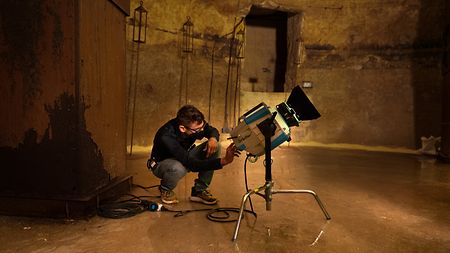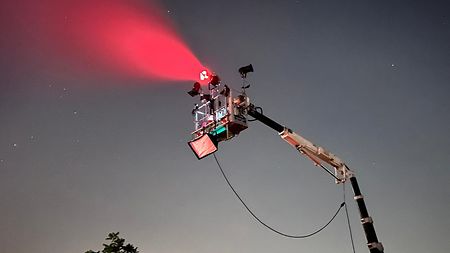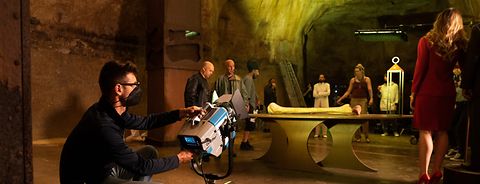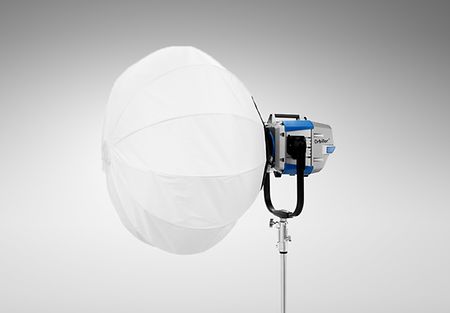“The Springtime of My Life” (“La primavera della mia vita”) is director Zavvo Nicolosi’s debut feature, starring Sicilian singers Colapesce and Dimartino. Cinematographer Carlo Rinaldi has previously collaborated with Francesco Bruno on the film “Everything’s Gonna Be Alright” and the TV series “Everything Calls for Salvation.” He also authored the cinematography for the series “The King” and Pietro Castellitto’s debut feature “The Predators.” In this interview, he talks about using the Orbiter with projection optics and other ARRI lighting fixtures on “The Springtime of My Life.”
What visual setting did you seek for “The Springtime of My Life” with director Zavvo Nicolosi?
Zavvo shot all the music videos by Colapesce and Dimartino, so we were starting from the visual setting of those projects. Their video clips offer a very specific imagery: It's as if they live in a very particular, somewhat fairy world. The basic references were Wim Wenders' “Paris, Texas” and “Until the End of the World,” films by Ari Kaurismaeki, and Wes Anderson, with a lot of symmetrical shots and a direction composed of cuts, without long shots and big camera movements. Zavvo also recommended that I see David Byrne's “True Stories,” a film by a musician-turned-director, all set in Texas. This project is very much about the land, but at the same time also about the music. These two aspects fit like a glove for “The Springtime of My Life,” a road movie in which Colapesce and Dimartino portray Sicily through a series of stages. The region becomes one of the protagonists of the story. In addition, there is a very ironic and zany comedy part that may remind viewers of Roberto Benigni’s “Nothing Left to Do But Cry” or the Italian comedy duo Franco & Ciccio’s films. A hysterical comedy of the absurd with musical performances, for example a song by Italian rapper Madame and one by Colapesce and Dimartino, integrated within the film.

Sicilian singers Colapesce (r.) and Dimartino in “The Springtime of My Life”
Did you encounter particular technical difficulties?
The biggest challenge was related to the film being a road movie. We only had 30 days of shooting and we shot in a myriad of locations, which were very beautiful by the way. The challenge was to describe Sicily without making it look like a postcard. We shot in remote locations such as badlands, beaches, an island, or a boat. This led to situations that were quite complex to manage in terms of production logistics and lighting. The shoot took place in summer, with very harsh light, and my approach was to go with the situation, trying to soften that light in sometimes remote landscapes. When we went to the badlands I thought of western settings, in the big frescoed buildings I thought of 19th-century films. To cut it short: I was adapting.
What was your greatest accomplishment?
Casting myself in the imagery of Colapesce and Dimartino. I keep saying that comedy is not my genre, but over time I have discovered that I am capable of doing it. My projects, however, are always somewhat strange comedies like Pietro Castellitto's “The Predators” or Francesco Bruni's “Everything’s Gonna Be Alright.” The references I mentioned also gave me the opportunity to look at legendary cinematographers like Robby Mueller and Vittorio Storaro, as well as to play a lot with color without having to be realistic. There are almond trees in the film that emit a blue light, or caves lit in green like in “The X-Files,” so I was able to indulge in color. Because the shots were so defined, this was one of the very few projects where I also wanted to be a camera operator and create the framing myself.

DP Carlo Rinaldi used the ARRI Orbiter extensively to illuminate various scenes
How did the choice of format come about?
The choices of lens and camera originated from the format. We wanted it square and chose 1:66, a historical format that Stanley Kubrick, Bernardo Bertolucci, and Wong Kar-Wai used. It’s a very nice format, a rectangle, but not cinematic like Sergio Leone’s. I wanted a little space on top, I wanted to see the ceilings, the skies, and in order to achieve that, I had to stay in the world of spherical lenses. As a great lover of vintage lenses, I chose a set of Cooke Panchro lenses. Director Zavvo Nicolosi as well as the protagonists Colapesce and Dimartino are attached to a certain retro look; they love analog, and vintage expressed with clothing, props, and visual style.
You made extensive use of ARRI Orbiter to light the film, how did that work?
I made choices that looked to the past, but also some that related to the future. I used ARRI Orbiters and ARRI SkyPanels, a kit of LEDs that helped me so much to work on color, combined with classic incandescent, tungsten fixtures, such as the Jumbo, panels that collect multiple PAR lamps. They are very intense and generate a lot of warm light. So I tried to combine these two worlds.

“The strength of ARRI Orbiter is certainly its compatability with other LED panels,” says DP Carlo Rinaldi
What has been the added value of the ARRI Orbiter?
The strength of the ARRI Orbiter is certainly its compatability with other LED panels. The classic LED panels are 60 or 120 centimeters and make a soft light, perhaps even intense, but scattered. The strength of Orbiter, on the other hand, is to create a concentrated, point-like light. The world of LEDs for cinema did not have this, but finally Orbiter offered me a LED that produces a directional light, a beam, to complement the other, more popular lights. In addition, its peculiar point light can be easily transformed by connecting a dome or soft box to it, which other LED panels cannot do. Another great advantage is that the Orbiter is part of an ARRI ecosystem in which you can select a particular gel color that you can find identical on SkyPanels as well.

The ARRI Orbiter on a crane was crucial for a dream scene in “The Springtime of My Life”
Is there a particular scene in which ARRI Orbiter was very helpful to you in achieving the result you sought?
There is a dream scene in the film, a kind of vision of a memory that Colapesce has after ingesting a hallucinogen. It was originally supposed to be shot in black and white to be clearly detached from the rest of the film, which is quite colorful. But then Zavvo and the two protagonists were sorry to lose the color component. I then proposed to do the scene in red and black, with predominantly red light everywhere. In the sequence he takes the hallucinogen in one place, falls asleep, and wakes up in the same place, but at that point there is no one there. We're in the middle of nature, he's bathed in red light, and the camera follows him through a series of situations linked together by a dolly or whip pan: You see him as a child, him with his dad, him with his ex-girlfriends, him at school with nuns. For this scene, the Orbiter was crucial: It was always the main light that created the cone of light on the actor, and around Orbiter, positioned on a crane that went up to about thirty meters, there were SkyPanels and PARs. I could create the same red color with all three tools and get a soft wash of red everywhere, with individual spots on a character or specific set elements. Another interesting scene in terms of lighting was the one shot in a cave. It is an old water cistern on the island of Ortigia, a huge, majestic place under a church, where we staged a kind of conference of plotters. The whole cave was illuminated with a dot of green. Orbiter illuminated in direct backlighting, obscured by the character, with the podium and the speaker seen from behind, creating a green outline.




